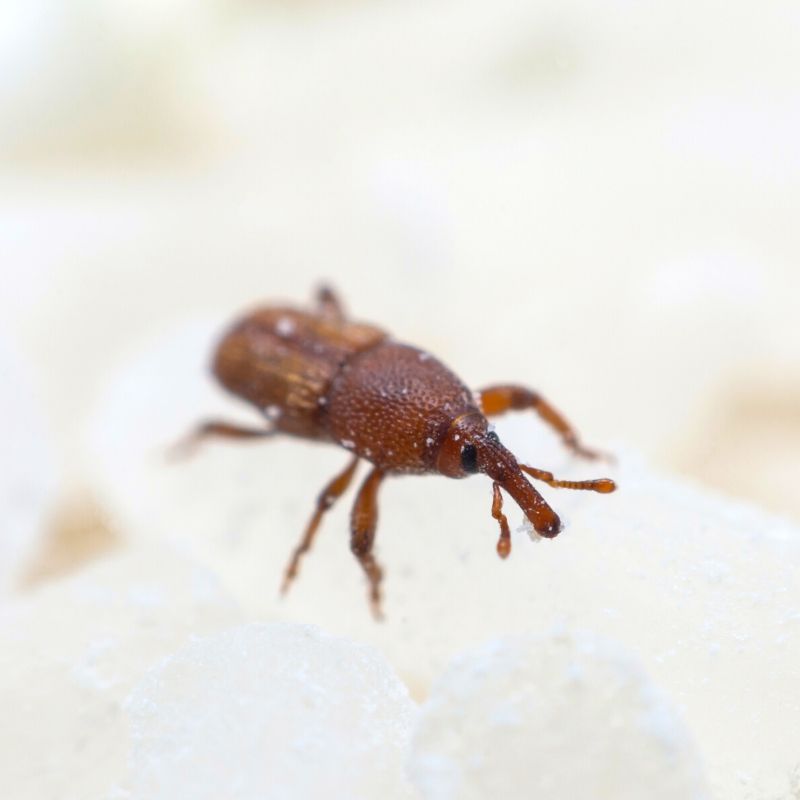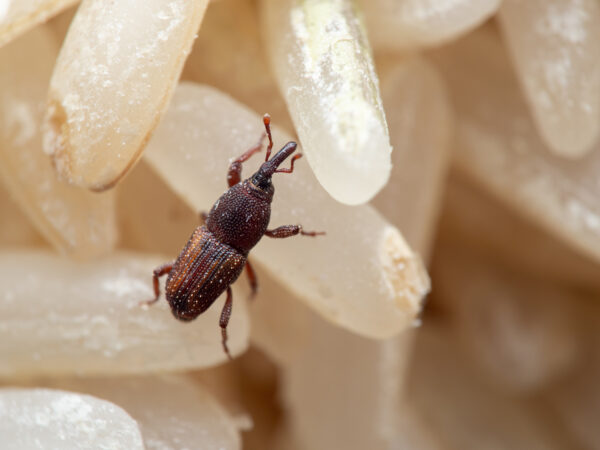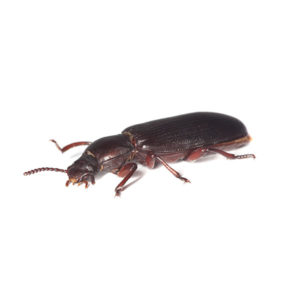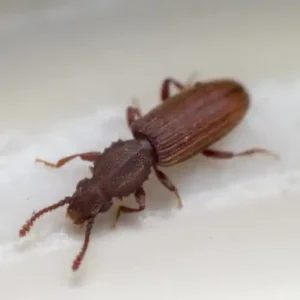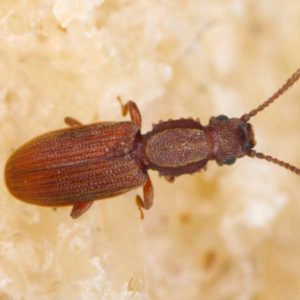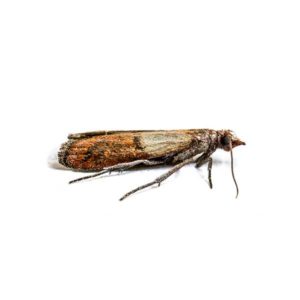What Are Rice Weevils?
The rice weevil (Sitophilus oryzae) is distributed worldwide and is a serious stored-grain pest that lives, feeds, and breeds inside food products. More prominent in the southern United States, rice weevil adults and larvae feed on whole grains. Often called flour bugs, these snout-nosed beetles infest rice, flour, nuts, beans, seeds, cereals, and especially macaroni. Adults can fly and are attracted to light. Adult weevils are brown with four reddish-orange spots on their wing covers, and their snouts make them easily recognizable compared to other pantry pests. They are small, typically measuring 2-3 millimeters, and their compact size allows them to enter tiny cracks and crevices in food storage areas. The larval rice weevil must complete its development inside a seed kernel or a man-made equivalent, like macaroni products.
What Habitats Are Rice Weevils Found In?
Rice weevils are most commonly found in environments where grains or seeds are stored, including homes, grain storage facilities, food processing plants, and whole-food markets. They are especially attracted to dry, warm places where food is not stored securely. Rice weevils thrive in areas with a steady food supply, such as pantries containing rice, beans, birdseed, sunflower seeds, dried corn, macaroni, and spaghetti. Weevils are internal feeders and are also found in grain storage facilities, food processing plants, and whole-food markets.
The primary factor drawing rice weevils to these habitats is the availability of unprotected food sources. Open containers or improperly sealed packaging create ideal conditions for infestations. Rice weevils are particularly attracted to whole grains but will also infest processed grain products. Keeping an eye on high-risk areas like pantry corners and overlooked shelves is key to detecting their presence early.
How Does An Infestation of Rice Weevils Begins?
Rice weevil infestations typically start in the field, where adults infest crops and contaminate food processing facilities. These pests can go undetected during harvesting and packaging, entering homes when contaminated food items are purchased from shops. Once inside, rice weevils can easily spread through your pantry, moving from one product to another if food items are not stored in airtight containers.
A few undetected adult weevils or larvae are all it takes to initiate a rice weevil infestation. Since female weevils can lay hundreds of eggs during their lifetime, even a small number can quickly escalate into a widespread problem. The larvae develop inside grains, making them difficult to detect until visible signs like damaged packaging, holes in grains, or crawling adult weevils appear. Regularly inspecting and properly storing food items can help prevent infestations.
Are Rice Weevils Dangerous?
Rice weevils do not harm people, pets, or home furnishings. However, they damage grains and seeds, leading to food waste and contamination. Weevils feed on almost every processed, grain-based food consumed by people, and their small size allows them to enter even the smallest openings in packaging. This makes them a common household pest.
While rice weevils are not directly harmful to humans, their contamination of food poses indirect risks. Ingesting infested grains or seeds, especially if unnoticed, can lead to health concerns such as allergic reactions or digestive discomfort. Due to weevil activity, contaminated food often develops mold or bacteria, further increasing the risk of illness. . Since rice weevils feed inside food packaging, they can remain hidden in the pantry for a long time. Homeowners will often spot adult weevils crawling on pantry shelves and floors.
If an infestation is present in your Florida home, locate and discard all infested material. Contact your local pantry pest control experts for help with rice weevils!
What Is The Rice Weevil Life Cycle?
The rice weevil’s life cycle consists of four stages: egg, larva, pupa, and adult. Female rice weevils lay between 300 to 400 eggs during their lifetime, depositing them individually inside grains or seeds. Once the eggs hatch, the larvae feed on the inside of the grain, hollowing it out as they grow. This stage is the most damaging to stored grain products.
After completing the larval stage, the weevils enter the pupal stage, still inside the grain kernel. In favorable conditions, the development from egg to adult can take as little as 30 days. Adults emerge by boring small holes in the grains, a telltale sign of infestation. Adult weevils can live for 7 to 8 months, continuing to reproduce and spread if left unchecked. This rapid life cycle enables rice weevils to multiply quickly, making early detection and control vital.
How To Prevent Rice Weevils
Preventing rice weevil infestations involves proper food storage and hygiene practices:
- Inspect grains and rice before purchasing: Look for damaged packaging or signs of contamination.
- Store food in airtight containers: This prevents rice weevils from accessing and infesting food.
- Clean pantry shelves regularly: Remove crumbs and spilled food that may attract pests.
- Freeze new food items: Placing grains or rice in the freezer for three days can kill any eggs or larvae present.
- Rotate your food supply: Use older food items first to minimize the chances of infestation.
By following these steps you can protect your home from rice weevil infestations.
Frequently Asked Questions
Can You Still Eat Rice With Weevils?
It is not advisable to eat rice infested with weevils. While they are not harmful if accidentally ingested, the presence of larvae or adult weevils indicates contamination that can lead to food spoilage or health risks.
Why Do I Have Rice Weevils In My House?
Rice weevils typically enter homes through infested food items. They are attracted to stored grains and seeds that are improperly sealed or left in open containers.
How Do Weevils Get Into Sealed Containers?
Weevils can enter improperly sealed containers through tiny openings. They may also already be present in food items before storage, making airtight containers essential.
Are Rice Weevils In Every Bag Of Rice?
Not every bag of rice is infested, but rice weevils are a common pest in stored grains. Always inspect rice before purchasing and follow proper storage practices to prevent infestations.
Should I Throw Out Flour With Weevils?
Yes, flour infested with weevils should be discarded. Infested products are contaminated and can lead to further infestations if not properly disposed of.

